
Topology of Violence - Han, Byung-Chul
Topology of Violence
In his book "Topology of Violence," Byung-Chul Han presents a novel and provocative exploration of the relationship between violence and power in contemporary society. Drawing on a wide range of sources, including philosophy, sociology, and political theory, Han argues that violence has undergone a fundamental transformation in the modern era, shifting from a physical and external force to a more subtle and insidious form of power that operates through social and psychological mechanisms.
The New Face of Violence
Han begins by arguing that traditional notions of violence, which focus on physical harm and coercion, are no longer adequate for understanding the ways in which power is exercised in contemporary society. Instead, he proposes a new understanding of violence as a form of "power that operates through the production of difference and otherness." This new form of violence, which he terms "structural violence," is more insidious and pervasive than traditional forms of violence, as it operates through social and psychological mechanisms to produce and maintain social hierarchies and inequalities.
The Topology of Power
Han develops his argument by drawing on the concept of "topology," which he uses to describe the ways in which power is distributed and exercised in society. He argues that power is not a fixed or centralized entity, but rather a dynamic and fluid force that operates through networks and flows. This topological understanding of power allows Han to show how violence is not simply a negative or destructive force, but also a productive force that shapes and structures social reality.
The Violence of the Other
One of the central themes of Han's book is the role of the "other" in the production of violence. He argues that violence is often directed at those who are perceived as different or other, and that this violence serves to maintain social hierarchies and inequalities. Han draws on a variety of examples, from the Holocaust to the Rwandan genocide, to illustrate how the construction of the other as a threat or enemy can lead to violence and destruction.
The Politics of Resistance
In the final section of the book, Han considers the possibilities for resistance against the violence of power. He argues that resistance must be based on a recognition of the topological nature of power and the role of the other in the production of violence. Resistance, he suggests, must be creative and transformative, and must aim to disrupt the networks and flows of power that produce violence.
Conclusion
"Topology of Violence" is a challenging and provocative book that offers a new and insightful perspective on the relationship between violence and power in contemporary society. Han's analysis is both theoretically sophisticated and empirically grounded, and he draws on a wide range of sources to support his arguments. The book is essential reading for anyone interested in understanding the nature of violence and the possibilities for resistance in the modern world.